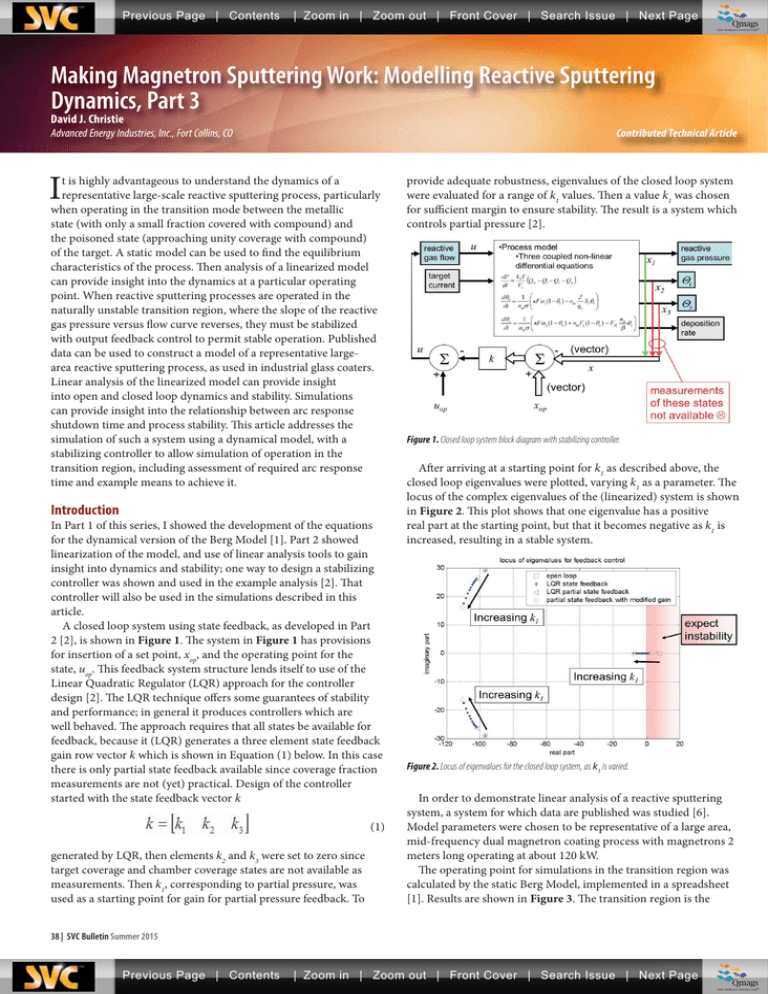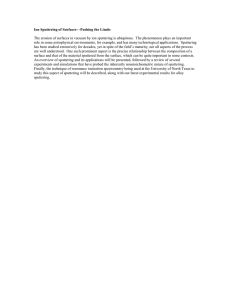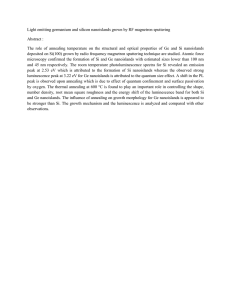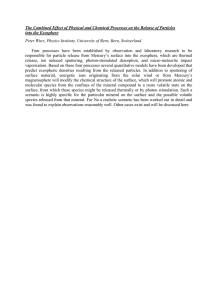Modelling Reactive Sputtering Dynamics, Part 3
advertisement

Previous Page | Contents | Zoom in | Zoom out | Front Cover | Search Issue | Next Page M q M q M q M q MQmags q THE WORLD’S NEWSSTAND® Making Magnetron Sputtering Work: Modelling Reactive Sputtering Dynamics, Part 3 David J. Christie Advanced Energy Industries, Inc., Fort Collins, CO Contributed Technical Article I t is highly advantageous to understand the dynamics of a representative large-scale reactive sputtering process, particularly when operating in the transition mode between the metallic state (with only a small fraction covered with compound) and the poisoned state (approaching unity coverage with compound) of the target. A static model can be used to ind the equilibrium characteristics of the process. hen analysis of a linearized model can provide insight into the dynamics at a particular operating point. When reactive sputtering processes are operated in the naturally unstable transition region, where the slope of the reactive gas pressure versus low curve reverses, they must be stabilized with output feedback control to permit stable operation. Published data can be used to construct a model of a representative largearea reactive sputtering process, as used in industrial glass coaters. Linear analysis of the linearized model can provide insight into open and closed loop dynamics and stability. Simulations can provide insight into the relationship between arc response shutdown time and process stability. his article addresses the simulation of such a system using a dynamical model, with a stabilizing controller to allow simulation of operation in the transition region, including assessment of required arc response time and example means to achieve it. Introduction In Part 1 of this series, I showed the development of the equations for the dynamical version of the Berg Model [1]. Part 2 showed linearization of the model, and use of linear analysis tools to gain insight into dynamics and stability; one way to design a stabilizing controller was shown and used in the example analysis [2]. hat controller will also be used in the simulations described in this article. A closed loop system using state feedback, as developed in Part 2 [2], is shown in Figure 1. he system in Figure 1 has provisions for insertion of a set point, xop, and the operating point for the state, uop. his feedback system structure lends itself to use of the Linear Quadratic Regulator (LQR) approach for the controller design [2]. he LQR technique ofers some guarantees of stability and performance; in general it produces controllers which are well behaved. he approach requires that all states be available for feedback, because it (LQR) generates a three element state feedback gain row vector k which is shown in Equation (1) below. In this case there is only partial state feedback available since coverage fraction measurements are not (yet) practical. Design of the controller started with the state feedback vector k (1) generated by LQR, then elements k2 and k3 were set to zero since target coverage and chamber coverage states are not available as measurements. hen k1, corresponding to partial pressure, was used as a starting point for gain for partial pressure feedback. To provide adequate robustness, eigenvalues of the closed loop system were evaluated for a range of k1 values. hen a value k1 was chosen for suicient margin to ensure stability. he result is a system which controls partial pressure [2]. Figure 1. Closed loop system block diagram with stabilizing controller. Ater arriving at a starting point for k1 as described above, the closed loop eigenvalues were plotted, varying k1 as a parameter. he locus of the complex eigenvalues of the (linearized) system is shown in Figure 2. his plot shows that one eigenvalue has a positive real part at the starting point, but that it becomes negative as k1 is increased, resulting in a stable system. Figure 2. Locus of eigenvalues for the closed loop system, as k1 is varied. In order to demonstrate linear analysis of a reactive sputtering system, a system for which data are published was studied [6]. Model parameters were chosen to be representative of a large area, mid-frequency dual magnetron coating process with magnetrons 2 meters long operating at about 120 kW. he operating point for simulations in the transition region was calculated by the static Berg Model, implemented in a spreadsheet [1]. Results are shown in Figure 3. he transition region is the 38 | SVC Bulletin Summer 2015 Previous Page | Contents | Zoom in | Zoom out | Front Cover | Search Issue | Next Page M q M q M q M q MQmags q THE WORLD’S NEWSSTAND® Previous Page | Contents | Zoom in | Zoom out | Front Cover | Search Issue | Next Page M q M q M q M q MQmags q THE WORLD’S NEWSSTAND® portion in the curves where the sign of the slope is reversed with respect to the beginning and end of the curves. In general, open loop operation in the transition region is impossible, so feedback control must be used to achieve operation there. A representative transition region operating point chosen for the simulations described next is denoted by the diamonds on the curves. Figure 3. Oxygen partial pressure and deposition rate versus oxygen low calculations from the static model. The transition region operating point for simulations is denoted by the diamonds on the curves. Arc Response Dynamics One consideration of paramount importance is the stability of the reactive sputtering process. Stability can have broad meaning. here is on one hand the intrinsic stability, which oten implies freedom from oscillation, or perhaps, the ability to stay within a bound-able neighborhood of a desired operating point. While this notion of stability is quite applicable, and important, to reactive sputtering processes, there is another notion of stability which must be also considered. Reactive sputtering processes are by their nature prone to arcing. he dielectric material which forms on the target surface in some processes is believed to accumulate electrical charge to the point where it breaks down and initiates an arc from the plasma to the target, where the glow discharge over much of the target surface collapses to a small diameter arc [3]. When an arc does occur, it must be handled by the system power supply. his typically entails an interruption in the power delivered to the process for some period of time. If power to the process is interrupted for long enough, it can move signiicantly away from its desired operating point, and take some time to return once the power is re-applied. When power is reapplied, the reactive gas pressure, target surface coverage, chamber surface coverage, electrical impedance and deposition rate will have changed. It is clearly important to develop an understanding of these issues, analytically and numerically as well as empirically [4]. To fully realize the potential of reactive sputtering, it will be necessary to systematically develop an understanding based on reliable mathematical models which capture the essential physics of the process. his article addresses the issue by using a modelbased approach to examine acceptable maximum power supply arc response shut down times for a representative industrial glass coating process. Simulations were performed with Simulink® [5]. Results of continued on page 40 Mix it. Mix it good. The Burkert All-in-one Gas Mixing Box is a multi-gas mixer or dispenser for 2 to 4 gasses. It can be ordered as a mixer with max 4 inlets and 1 outlet or as a dispenser with one inlet and max 4 outlets and uses unique Burkert Mass Flow Controllers with CMOS technology. These MFCs are known for fast response time, low pressure drop and superb stability. The MFCs work with wide range of non-corrosive gases. A touch panel display is used to enter set points and to display outputs while internal communication is based on RS485, entirely digital. This gas mixer could be used across a wide variety of applications including vacuum coating, food packaging, bio-reactors, cutting and welding, flame control, heat treatment and analyzers. We make ideas flow. www.burkert-usa.com Summer 2015 SVC Bulletin | 39 Previous Page | Contents | Zoom in | Zoom out | Front Cover | Search Issue | Next Page M q M q M q M q MQmags q THE WORLD’S NEWSSTAND® Previous Page | Contents | Zoom in | Zoom out | Front Cover | Search Issue | Next Page M q M q M q M q MQmags q THE WORLD’S NEWSSTAND® Making Magnetron Sputtering Work: Modelling Reactive Sputtering Dynamics, Part 3 It is also important to note that even if partial pressure could be held absolutely constant, the coverage fraction would increase, with a concomitant decrease in normalized rate. continued from page 39 simulations performed using this model highlight the need for rapid arc response and a managed low arc rate in practical industrial reactive sputtering processes. he results show partial pressure, target coverage fraction, chamber surfaces coverage fraction, and deposition rate as a function of time. Model parameters, listed in Table 1 in Part 2 [2], were chosen to be representative of a large area, mid-frequency dual magnetron coating process with magnetrons 2 meters long operating at about 120 kW [6]. Response of the process to a 20 msec arc shutdown is shown in Figure 4. he efect of the shutdown on the deposition rate lasts much longer than the shutdown time, and would likely result in visible “banding” on the product coated in an inline glass coater. he drop in rate is much larger than that which might be anticipated by simply looking at partial pressure or target coverage fraction. In fact, a small increase in target coverage fraction can result in a large drop in metal lux to the target because the compound sputters with a much lower yield than the target material. It seems unlikely that this process could be stabilized if shutdowns of this length occurred a few times a second. Figure 5. Normalized rate as a function of coverage fraction for the modeled TiO2 process. A loss of rate may not be the only efect of a long shutdown for arc response. he average target surface coverage fraction also increases, as seen in Figure 4. his could result in a change of ilm properties as well. Experimental data for deposition of AlOx in the transition region shows that the index of refraction decreases from 1.66 to 1.61 as partial pressure is increased, while remaining in the transition region [7]. As partial pressure increases, target surface coverage fraction also increases, approaching unity. herefore, it could be that longer shutdown times result in ilms with lower index of refraction, and perhaps reduced density. Response of the process to a 5.0 msec arc shutdown is shown in Figure 6. Even a 5.0 msec shutdown results in a signiicant disturbance to the process, and it takes some time for the rate to recover to the pre-shutdown level. Figure 4. Process response to 20 msec power supply shutdown in response to an arc. Figure 5 shows normalized rate as a function of coverage fraction. Normalized rate is the efective target material sputtering yield, including both intrinsic target material and target material incorporated in compound at the target surface. he expression for normalized rate, Rnorm, is (2) where θt is the fraction of the target covered with compound, SM (atoms/ion) is the sputtering yield of the target material, β is the number of metal atoms in the compound, and SC (atoms/ion) is the sputtering yield of the compound. Both the equilibrium normalized rate and the normalized rate ater a 20 msec shutdown are shown in Figure 5. he equilibrium coverage fraction is 0.76, with a normalized rate of 0.27. Ater a 20 msec shutdown, when power is reapplied, the coverage fraction is 0.90, with a normalized rate of 0.13. his explains why just a 20% increase in target coverage fraction can result in a 50% decrease in rate at the time when power is reapplied following an arc response shutdown. Figure 6. Process response to 5.0 msec power supply shutdown in response to an arc. Response of the process to a 1.0 msec arc response shutdown is shown in Figure 7. he longer term efect on rate is in the range of a few percent. An arc response shutdown on the order of 1.0 msec or less allows process operation to continue nearly seamlessly ater power is restored. 40 | SVC Bulletin Summer 2015 Previous Page | Contents | Zoom in | Zoom out | Front Cover | Search Issue | Next Page M q M q M q M q MQmags q THE WORLD’S NEWSSTAND® Previous Page | Contents | Zoom in | Zoom out | Front Cover | Search Issue | Next Page M q M q M q M q MQmags q THE WORLD’S NEWSSTAND® process studied here. he result of longer shutdown times is a reduction of deposition rate. An additional efect of longer shutdown times may be a change in index of refraction of the ilms, owing to the increase in average target surface coverage fraction. Experimental data has shown that pulsed current source supplies optimized for large area mid-frequency dual magnetron sputtering processes can have shutdown times of 50 msec or less. References 1. D.J. Christie, “Making Magnetron Sputtering Work: Modelling Reactive Sputtering Dynamics, Part 1,” SVC Bulletin, p. 24-27, Society of Vacuum Coaters, Fall 2014. 2. D.J. Christie, “Making Magnetron Sputtering Work: Modelling Reactive Sputtering Dynamics, Part 2,” SVC Bulletin, p. 30-33, Society of Vacuum Coaters, Spring 2015. 3. A. Belkind, A. Freilich, “Electrical Dynamics of Pulsed Plasmas,” 41st Annual Technical Conference Proceedings, Society of Vacuum Coaters, p. 321-326, 1998. 4. U. Krause, M. Schulze, H. Fuchs, “Requirements for the System Power Supply Sputter Source for High Power Pulsed Magnetron Sputtering,” Proc. of the 3rd ICCG, p. 173, 2000. Arc Response Requirements 5. Using Simulink®, The Mathworks®, Natick, 2002. In general, it is desirable to minimize the time the power supply shuts of in response to an arc. It is necessary to shut of long enough to extinguish the arc, but not so long that available deposition rate is wasted. he simulation results in the previous section showed that a key requirement for stabilization of the deposition rate for processes operating in the transition region is a rapid arc response, less than 1 msec for the system studied. Pulsed supplies for dual magnetron sputtering (DMS) have been developed starting in the mid-1990s [8-11]. Arc response from a recently developed mid-frequency pulsed current source supply for DMS [12-15] is shown in Figure 8 for SiO2 at 60 kW. Full power is restored in the opposite polarity within about one half-cycle of shutting down to handle an arc. his likely represents about the fastest possible response time for a pulsed dual magnetron reactive sputtering process, with less than a half cycle shutdown time; much less than the guideline of 1.0 msec or less suggested by the simulations. 6. P. Greene, R. Dannenberg, “Modeling of Production Scale Reactive Deposition,” 42nd Annual Technical Conference Proceedings, Society of Vacuum Coaters, p. 23-28, 1999. 7. W.D. Sproul, B.E. Sylvia, “Multi-Level Control for Reactive Sputtering,” 45th Annual Technical Conference Proceedings, Society of Vacuum Coaters, p. 11-15, 2002. 8. D.J. Christie, D. Kovalevskii, D.E. Morgan, E.A. Seymour , “A New Generation of Power Supplies for Large Area Dual Magnetron Sputtering,” 44th Annual Technical Conference Proceedings, Society of Vacuum Coaters, p. 228-233, 2001. 9. D.J. Christie, D.M. File, D.R. Frost, D. Kovalevskii, D.E. Morgan, D.R. Pelleymounter, G.C. Roop, “High Performance Pulsed Current Source Supplies for Large Area Dual Magnetron Sputtering,” Proc. of the 3rd ICCG, p. 107, 2000. Figure 7. Process response to 1.0 msec power supply shutdown in response to an arc. 10. R. A. Scholl, D.J. Christie, US Patent No. 5,917,286, “Pulsed Direct Current Power Supply Configurations for Generating Plasmas,” (filed May 8, 1996; published June 29, 1999) 11. R.A. Scholl, D.J. Christie, US Patent No. 6,222,321, “Plasma Generator Pulsed Direct Current Supply in a Bridge Configuration,” (priority May 8, 1996; filed June 8, 1999; published April 24, 2001) 12. D.J. Christie, K.W. Finley, U. Krause, S.B. Larson, S. Kovacevic, “Selectable Frequency, Pulsed Current Source Supplies for Large Area Dual Magnetron Sputtering,” Proc. of the 9th ICCG, p. 369-374, 2012. 13. D.J. Christie, S.B. Larson, B.D. Kowal, and J.B. Pankratz, “A New Generation of Flexible Power Supplies for Dual Magnetron Sputtering,” 56th Annual Technical Conference Proceedings, Society of Vacuum Coaters, p. 188-191, 2013. 14. D.J. Christie, S.B. Larson, U. Krause, D.R. Pelleymounter, “Towards More Efficient Dual Magnetron Sputtering (DMS): Strategies for Reducing Cost of Ownership,” 57th Annual Technical Conference Proceedings, Society of Vacuum Coaters, p. 127-129, 2014. 15. D.J. Christie, S.B. Larson, U. Krause, D.R. Pelleymounter, “Evolving Dual Magnetron Sputtering (DMS): Strategies for Increased Control and Efficiencies,” Proc. of the 10th ICCG, p. 53-56, 2014. About the Author David Christie David Christie received his PhD from Colorado State University, is currently Director, Applications Technology with Advanced Energy, and is serving his second term on the SVC Board of Directors. His first SVC paper was in 1996, on pulsed dual magnetron sputtering. He has more than 40 thin film related publications, and 6 related patents. For further information, contact David Christie, at dave.christie@aei.com. ____________ Figure 8. Current fed DMS waveform showing improved arc handling with fast current reduction for a magnetron sputtering process operating at 60 kW. Summary and Conclusions Process simulations showed that power supply arc response shutdowns need to be of order 1.0 msec or less to minimize disturbance to the large area transition mode reactive sputtering Summer 2015 SVC Bulletin | 41 Previous Page | Contents | Zoom in | Zoom out | Front Cover | Search Issue | Next Page M q M q M q M q MQmags q THE WORLD’S NEWSSTAND®


